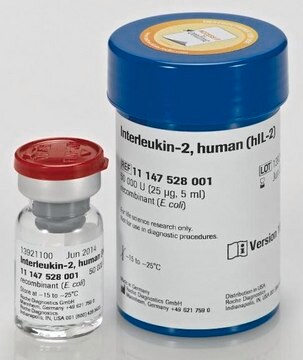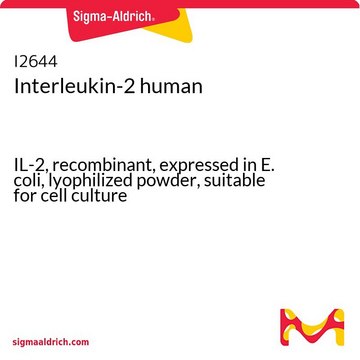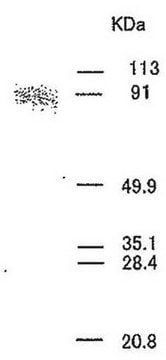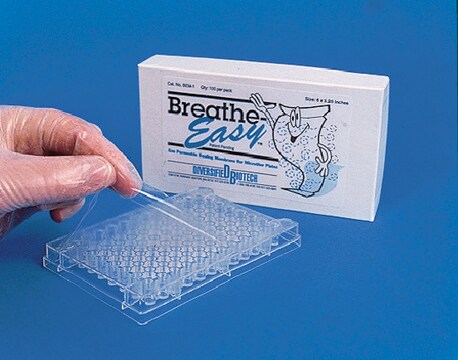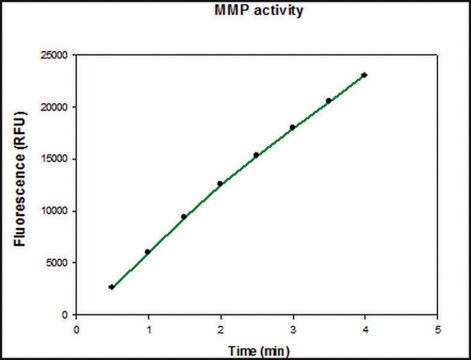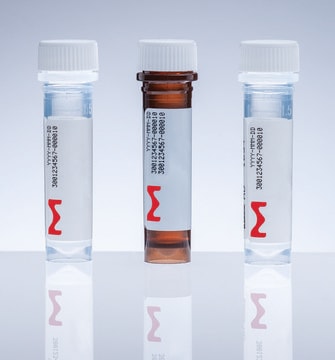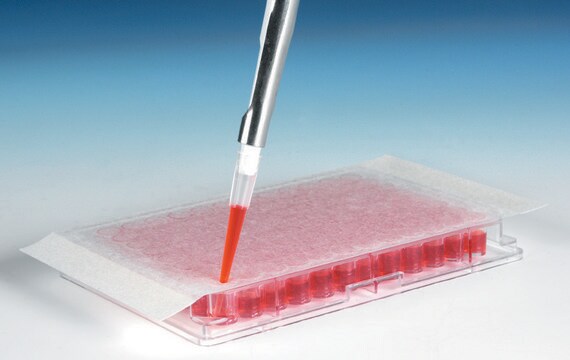IM09L
Anty-MMP-9 (Ab-1) mysie mAb (6-6B)
lyophilized, clone 6-6B, Calbiochem®
Zaloguj sięWyświetlanie cen organizacyjnych i kontraktowych
About This Item
Kod UNSPSC:
12352203
NACRES:
NA.41
Polecane produkty
pochodzenie biologiczne
mouse
Poziom jakości
forma przeciwciała
purified antibody
rodzaj przeciwciała
primary antibodies
klon
6-6B, monoclonal
Formularz
lyophilized
nie zawiera
preservative
reaktywność gatunkowa
human
producent / nazwa handlowa
Calbiochem®
warunki przechowywania
OK to freeze
izotyp
IgG1
Warunki transportu
ambient
temp. przechowywania
2-8°C
docelowa modyfikacja potranslacyjna
unmodified
informacje o genach
human ... MMP9(4318)
Opis ogólny
Metaloproteinazy macierzy (MMP′) to rodzina enzymów odpowiedzialnych za degradację składników macierzy zewnątrzkomórkowej, takich jak kolagen, laminina i proteoglikany. Oprócz homologii sekwencji, wszystkie MMP mają następujące cechy: mechanizm katalityczny zależy od jonu cynku w centrum aktywnym, rozszczepiają jeden lub więcej składników macierzy zewnątrzkomórkowej, są wydzielane jako zymogeny, które są aktywowane przez usunięcie segmentu ~ 10 kDa z końca N i są hamowane przez tkankowy inhibitor metaloproteinaz (TIMP). Enzymy te biorą udział w normalnych procesach fizjologicznych, takich jak embriogeneza i przebudowa tkanek, i mogą odgrywać ważną rolę w zapaleniu stawów, zapaleniu przyzębia i przerzutach. MMP-9 (żelatynaza B, żelatynaza 92 kDa/kolagenaza typu IV) jest wydzielana jako zymogen 92 kDa, który jest przetwarzany proteolitycznie do postaci aktywnej 83 kDa; wykryto również 68 kDa. MMP-9, wraz z najbliżej spokrewnionym członkiem rodziny MMP, MMP-2, wykazują specyficzność substratową wobec kolagenów typu IV i V, żelatyny i elastyny. Liczne badania wykazały korelację między ekspresją kolagenazy a potencjałem przerzutowym. Podwyższony poziom MMP-9 w osoczu sugeruje, że może to być przydatny marker do diagnozowania lub prognozowania raka w ogóle.
Oczyszczone mysie przeciwciało monoklonalne. Rozpoznaje ~92 kDa utajone i ~83 kDa aktywne formy ludzkiego MMP-9 w warunkach nieredukujących, ale tylko formę utajoną w warunkach redukujących.
Rozpoznaje utajone i aktywne formy MMP-9 o masie cząsteczkowej ~92 kDa i ~83 kDa w warunkach nieredukujących, ale tylko formę utajoną w warunkach redukujących. Hamuje aktywność enzymatyczną MMP-9. W przypadku skrawków parafinowych należy użyć nr kat. Nr kat. IM37L.
To mysie mAb anty-MMP-9 (Ab-1) (6-6B) zostało zatwierdzone do stosowania w immunoblottingu, immunoprecypitacji, badaniach neutralizacji, skrawkach parafinowych do wykrywania MMP-9 (Ab-1).
Immunogen
Człowiek
MMP-9 z pożywki kondycjonowanej stymulowanych PMA ludzkich komórek włókniakomięsaka HT-1080
Zastosowanie
Immunoblotting (2 µg/ml)
Immunoprecypitacja (patrz odniesienia do aplikacji)
Badania neutralizacji (patrz komentarze i odniesienia do aplikacji)
Skrawki parafinowe (niezalecane)
Immunoprecypitacja (patrz odniesienia do aplikacji)
Badania neutralizacji (patrz komentarze i odniesienia do aplikacji)
Skrawki parafinowe (niezalecane)
Ostrzeżenie
Toksyczność: Standardowa obsługa (A)
Postać fizyczna
Liofilizowany z lotnego buforu, 100 µg BSA.
Rekonstytucja
Przechowywać w temperaturze 4°C do czasu rekonstytucji, a następnie przechowywać w podwielokrotnościach w temperaturze -20°C lub 4°C z 0,1% azydkiem. Ponownie zawiesić przeciwciało w sterylnym PBS, pH 7,4, lub sterylnym 20 mM roztworze Tris-saline, pH 7,4, aby uzyskać końcowe stężenie 100 µg/ml; produkt będzie bardziej stabilny, jeśli zostanie dodany 0,1% azydek sodu (nie dodawać azydku, jeśli przeciwciało ma być stosowane z żywymi komórkami). Liofilizowane przeciwciała powinny być ponownie zawieszone w temperaturze 4°C z okazjonalnym delikatnym mieszaniem przez co najmniej 2 h. Zamrażanie podwielokrotności jest najlepsze do długotrwałego przechowywania odtworzonego produktu; należy unikać powtarzającego się zamrażania i rozmrażania.
Komentarz do analizy
Kontrola pozytywna
Białko MMP-9 (nr kat. PF024 lub PF038)
Białko MMP-9 (nr kat. PF024 lub PF038)
Inne uwagi
Cottam, D.W. i Rees, R.C. 1993. Intl. J. of Oncol.2, 861.
Nakajima, M., et al. 1993. Cancer Res.53, 5802.
Ramos-DeSimone, et al. 1993. Hybridoma. 12, 349.
Stetler-Stevenson, W.G., et al. 1993. FASEB.7, 1434.
Zucker, S., et al. 1993. Cancer Res.53, 140.
Woessner, J.F. 1991. FASEB. 5, 2145.
Liotta, L.A. i Stetler-Stevenson, W.G. 1990. w Seminars in Cancer Biology, red. M.M. Gottesman. Vol. 1; 99-106.
Nakajima, M., et al. 1993. Cancer Res.53, 5802.
Ramos-DeSimone, et al. 1993. Hybridoma. 12, 349.
Stetler-Stevenson, W.G., et al. 1993. FASEB.7, 1434.
Zucker, S., et al. 1993. Cancer Res.53, 140.
Woessner, J.F. 1991. FASEB. 5, 2145.
Liotta, L.A. i Stetler-Stevenson, W.G. 1990. w Seminars in Cancer Biology, red. M.M. Gottesman. Vol. 1; 99-106.
Hamuje aktywność enzymatyczną MMP-9. Do barwienia skrawków parafinowych należy użyć przeciwciała Anti-MMP-9 (626-644) (Ab-3) Mouse mAb (56-2A4) (nr kat. IM37L). Przeciwciało należy miareczkować w celu uzyskania optymalnych wyników w poszczególnych systemach.
Informacje prawne
Niedostępne w sprzedaży w Japonii.
CALBIOCHEM is a registered trademark of Merck KGaA, Darmstadt, Germany
Ta strona może zawierać tekst przetłumaczony maszynowo.
Nie możesz znaleźć właściwego produktu?
Wypróbuj nasz Narzędzie selektora produktów.
Kod klasy składowania
12 - Non Combustible Liquids
Klasa zagrożenia wodnego (WGK)
WGK 2
Certyfikaty analizy (CoA)
Poszukaj Certyfikaty analizy (CoA), wpisując numer partii/serii produktów. Numery serii i partii można znaleźć na etykiecie produktu po słowach „seria” lub „partia”.
Masz już ten produkt?
Dokumenty związane z niedawno zakupionymi produktami zostały zamieszczone w Bibliotece dokumentów.
Yao Tong et al.
Journal of inflammation research, 14, 5079-5094 (2021-10-23)
Acute lung injury (ALI) is a severe respiratory disease with high rates of morbidity and mortality. Many mediators regarding endogenous or exogenous are involved in the pathophysiology of ALI. Here, we have uncovered the involvement of integrins and matrix metalloproteinases
Min Hee Park et al.
Stem cells (Dayton, Ohio), 34(8), 2145-2156 (2016-04-20)
Hematopoietic stem/progenitor cell (HSPC) mobilization is an essential homeostatic process regulated by the interaction of cellular and molecular components in bone marrow niches. It has been shown by others that neurotransmitters released from the sympathetic nervous system regulate HSPC egress
Daniel J Price et al.
Cell communication & adhesion, 9(2), 87-102 (2002-12-19)
We studied the invasion of HMT-3522 breast epithelial cells in response to epidermal growth factor (EGF), and the associated signaling pathways. HMT-3522 T4-2 cells were shown to invade Matrigel-coated Transwell membranes in response to EGF while HMT-3522 S-1 cells failed
Andreas Behren et al.
Cancer research, 65(24), 11613-11621 (2005-12-17)
Papillomaviruses are involved in the development of cancers of the female cervix, head and neck, and skin. An excellent model to study papillomavirus-induced tumor induction and progression is the New Zealand White rabbit, where the skin is infected with the
Agnes Schäfer et al.
Frontiers in oncology, 12, 826273-826273 (2022-04-05)
Glioblastoma (GBM) as the most common and aggressive brain tumor is characterized by genetic heterogeneity, invasiveness, radio-/chemoresistance, and occurrence of GBM stem-like cells. The metalloprotease-disintegrin ADAM8 is highly expressed in GBM tumor and immune cells and correlates with poor survival.
Nasz zespół naukowców ma doświadczenie we wszystkich obszarach badań, w tym w naukach przyrodniczych, materiałoznawstwie, syntezie chemicznej, chromatografii, analityce i wielu innych dziedzinach.
Skontaktuj się z zespołem ds. pomocy technicznej